Fujifilm X-A7 mirrorless camera review
Fujifilm X-A7 In the fall of 2019, a Fujifilm X mount system camera model was released, designed for vloggers. The previous incarnation of this device was called the Fujifilm X-A5, and the current one is the Fujifilm X-A7. Recently, we managed to come to grips with testing it, and we willingly shared the results.
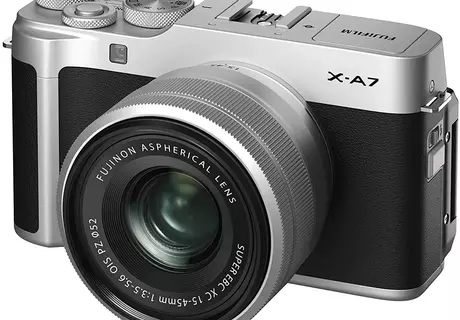
Fujifilm X-A7 mirrorless
The main thing
- 24MP CMOS APS-C
- Hybrid autofocus (AF) with 425 phase sensors
- Face and eye recognition function for autofocus
- Equivalent sensitivity to ISO 200-12800 (extendable to ISO 200-51200)
- Burst speed up to 6fps
- Video recording at maximum UHD 4K resolution (3840×2160) @ 30fps
- Sold with Fujinon XC 15-45mm f / 3.5-5.6 OIS PZ lens
- Supports SD / SDHC / SDXC UHS-I memory cards
- USB 2.0 interface
Fujifilm X-A Specification
| Model | Fujifilm X-A7 |
| Bayonet | Fujifilm X |
| Sensor | CMOS (CMOS), APS-C, 23.5 x 15.7 mm |
| Sensor resolution | 24.1 million effective pixels 1 (6000 × 4000) |
| footage format | JPEG (Exif v2.3); RAW (RAF) |
| Video recording resolution and duration | UHD 4K 3840 × 2160 @ 29.97 / 25/24 / 23.98p (up to 15 min.); Full HD 1920 × 1080 @ 59.94 / 50 / 29.97 / 25/24 / 23.98p (up to 30 min.); HD 1280 × 720 @ 59.94 / 50 / 29.97 / 25/24 / 23.98p (up to 30 min.); Full HD 1080 × 1080 @ 59.94 / 50 / 29.97 / 25/24 / 23.98p (up to 30 min.); HD 720 × 720 @ 59.94 / 50 / 29.97 / 25/24 / 23.98p (up to 30 min.); HD Rapid (accelerated): 1280 × 720 1.6 × / 2 × / 3.3 × / 4 × |
| Video recording format | MPEG-4 (H.264), Linear PCM stereo sound |
| Autofocus (AF) | hybrid, phase, and contrast; 425 zones |
| AF areas | point, zone, wide area |
| Focus modes | single frame, continuous, manual |
| Autoexposure measurement (AE) | 256-zone TTL; multi-segment, point, average |
| Exposure modes | SR + (Auto Scene Selection), P (Program), S (Shutter Priority), A (Aperture Priority), M (Manual), Panorama, Night Scene, Sports, Landscape, Portrait, SP (Scene Selection), Adv. (advanced filters) |
| Exposure compensation | photo: ± 5 EV in ⅓ steps; video: ± 2 EV in steps of ⅓ |
| Equivalent sensitivity | Photo: ISO 160-12 800, expandable to ISO 80-51 200; Video: ISO 400-6400 |
| Gate | focal plane vertical course, electronically controlled |
| Exposure ranges in different shooting modes | mechanical shutter : “P” – 4-1 / 4000 s, other modes – 30-1 / 4000 s, “Bulb” (hand exposure) – up to 60 minutes;mechanical + electronic shutter : “P” – 4-1 / 32000 s, other modes – 30-1 / 32000 s, “Bulb” (exposure by hand) – up to 60 minutes |
| Built-in flash | guide number 2 – 5.7; modes: auto, fill, slow sync, command, off; rear-curtain sync, red-eye removal electronic shutter : “P” – 4-1 / 32000 s, other modes – 30-1 / 32000; |
| X-sync shutter speed | 1/180 s |
| Self-timer | 2 s, 10 s |
| Rate of fire | H mode : 6 frames / s; L mode : 3 frames / s |
| Artistic effects | Toy Camera, Miniature, Pop color, High-key, Low-key, Dynamic tone, Soft focus, mono (red, orange, yellow, green, blue, purple) |
| Film Simulation Modes | Provia / Standard, Velvia / Vivid, Astia / Soft, Classic Chrome, Pro Neg.Hi, Pro Neg.Std, Monochrome, Monochrome + Ye Filter, Monochrome + R Filter, Monochrome + G Filter, Sepia |
| Display | Three ″ TFT, touch, movable in all planes |
| Interfaces | USB 2.0 (Type-C), HDMI (Type-D), microphone in, hot shoe (ISO 518) |
| Wireless connection | Wi-Fi (IEEE 802 / 11b / g / n), Bluet -4.2 BLE |
| Memory cards | one slot for SD / SDHC / SDXC (UHS-I, up to 256 GB) |
| Battery | Li-ion battery NP-W126S; 1260 mAh; up to 270 frames or up to 55 minutes of 4K 30p video (CIPA method) |
| Dimensions (edit) | 119 x 68 x 41 mm |
| Weight (with battery and memory card) | 320 g |
Based on the study of the specifications
it is possible to confirm our ward’s amateur and not professional orientation. It has a built-in flash, lacks a viewfinder and in-camera image stabilization, is equipped with only one slot for memory cards with a relatively low write and read speed (UHS-I). It is also structurally combined in one unit with a battery compartment. The minimum shutter speed of the mechanical shutter is limited to 1/4000 s, but an electronic shutter allows a much slower one – 1/32000 s.
The camera is replete with “amateur” shooting modes and artistic effects implemented in post-processing images. It also allows you to use “proprietary” modeling of different Fujifilm films. A modern USB Type-C connector represents the interface for communication with a computer. Still, it is implemented in USB 2.0, not fast enough by today’s standards. An audio jack for connecting headphones to monitor audio during video recording is not provided.
However, several characteristics make the Fujifilm X-A7 a serious camera. Although it has not a back (rear) direct (front) illumination of the light-receiving cells, a completely modern sensor has a resolution of 24 megapixels. An advanced autofocus (AF) system has sensors throughout the frame. Exposure compensation for still images is provided over a professional range of ± 5 EV in ⅓ increments. Video shooting is available in a maximum resolution of UHD 4K 3840×2160.
Design

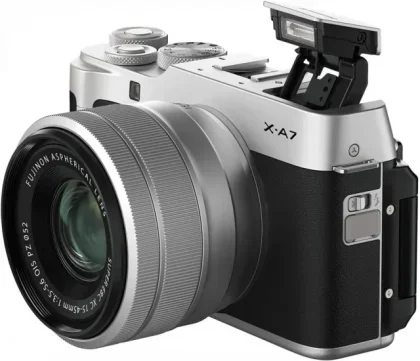
Compared to its predecessor (Fujifilm X-A5), our review’s heroine has undergone significant changes. Firstly, the controls on the rear panel have been significantly reduced, and secondly, the touchscreen display has become truly convenient due to its mobility in all planes.
At the front, only the AF illumination spotlight draws attention.

Behind, there are buttons for driving (switching between single-frame mode, continuous shooting, and self-timer), viewing footage (above the display), calling up the menu (Menu / OK), and returning (Disp / Back, to the right of the display). The five-position switch gave way to a mini-joystick.
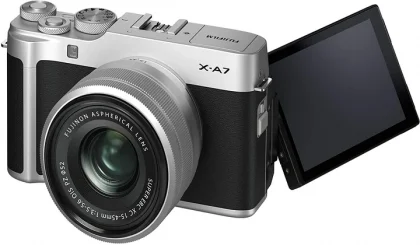
The built-in flash (recessed into the body when inoperative), a full-featured hot shoe, a shooting mode selector, front and rear control wheels, and a power-off button are above.
HDMI and USB Type-C connectors are found on the left under the cover. The button for forced ejection of the built-in flash and a connector for an external microphone (under the rubber cap) are correct.
If the Fujifilm X-A5 had only a folding display, then our heroine would have it with maximum mobility. She could install it in any position convenient for photography.
For taking selfies, the Fujifilm X-A5 could flip the display “facing you” upward, while the Fujifilm X-A7 has it displayed sideways for this purpose; it is much more convenient.
The camera has a lens with a zoom range of 15-45 mm (23-69 mm in full-frame equivalent). It has a relatively low aperture of f / 3.5-f / 5.6 but is equipped with optical image stabilization, which is intended to compensate for the above-mentioned limitation in aperture and the lack of an intra-chamber anti-shake system. Zooming is not done mechanically but electronically. That is, turning the zoom ring activates the motorized zoom drive.
SR +
The camera recognizes the specifics of the scene being shot, choosing from seven preset settings:
- Auto
- Portrait
- Landscape
- Night shot
- Macro
- Night portrait
- Backlit portrait
Following the scene, the parameters of the exposure triad (shutter speed, aperture, and sensitivity) are automatically set. If the photographer cannot match, choose program mode (P) or choose the scene type yourself (SP mode).
Adv. (Advanced Filter, improved filter)
You can play around by applying one of the artistic effects to the shot:
- Toy Camera
- Pop Color (active color)
- High-Key
- Low-Key
- Fish-Eye
- Dynamic Tone
- HDR Art (Wide Dynamic Range)
- Miniature
SP (Scene Position)
In this mode, automatic settings are available for typical scenes: portrait, landscape, sports, and night photos.
Display information
The lack of a viewfinder does not affect the camera’s information content when shooting. All parameters can be controlled “live,” guided by the display.
Read : FUJIFILM X-S10 live-action review
Fujifilm x-A7 Feature
1 – focusing area; 2 – data; 3 – focus control; 4 – assessment of the depth of field; 5 – download GPS data; 6 – image transmission; 7 – Bluetooth on / off; 8 – video mode; 9 – remaining recording time; 10 – current date and time; 11 – the remaining number of frames; 12 – image size and quality; 13 – warning about the difficulty of focusing; 14 – warning about camera heating; 15 – white balance; 16 – “button” for viewing the footage;
17 – emulation of types of film; 18 – dynamic range; 19 – “button” for calling the menu; 20 – sound and flash; 21 – histogram; 22 – distance scale; 23 – battery charge; 24 – sensitivity to light (ISO); 25 – exposure compensation; 26 – aperture value; 27 – exposure value; 28 – exposure memory (exposure lock); 29 – exposure metering mode; 30 – shooting mode.
31 – video mode; 32 – AF mode; 33 – indicator of successful AF; 34 – manual focus indicator; 35 – focus lock; 36 – zoom indicator; 37 – indicator of auto / manual focus; 38 – shutter type (mechanical/electronic); 39 – exposure indicator (underexposed/normal/overexposed); 40 – burst shooting mode; 41 – self-timer; 42 – a microphone is connected; 43 – the remote control is connected; 44 – flash mode; 45 – flash power compensation; 46 – image stabilization mode; 47 – touch-zoom (zoom by touching the screen). 42 – a microphone is connected; 43 – the remote control is connected; 44 – flash mode; 45 – flash power compensation; 46 – image stabilization mode; 47 – touch-zoom (zoom by touching the screen). 42 – a microphone is connected; 43 – the remote control is connected; 44 – flash mode; 45 – flash power compensation; 46 – image stabilization mode; 47 – touch-zoom (zoom by touching the screen).
Shooting modes
The camera provides a choice of advanced modes in addition to the traditional modes P, S, A, M, panorama, and direct scene-setting.
Shooting speed
The table shows the average shooting speed for different modes. Let’s call the first speed the one with which the burst recording starts. Its limitation is the time after which recording slows down and continues at a second speed. Units of measurement are frames per second and seconds, respectively. The infinity sign means that the speed has not altered throughout 100 frames.
| Mode | First speed | First speed limit | Second speed |
| JPEG Low | 2.8 fps | – | – |
| JPEG High | 6.2 fps | 1.3 s | 2.7 fps |
| RAW Low | 3.0 fps | 2.7 s | 1.7 fps |
| RAW High | 6.3 fps | 0.8 s | 1.7 fps |
The camera complies with the declared characteristics in terms of shooting speed. In the case of high-speed shooting H, it can shoot up to 6.3 fps; when shooting in JPEG, the buffer is enough for eight frames, and when shooting in RAW, for five frames.
Menu
The menu shouldn’t come as a surprise to users of previous Fuji cameras. Most of the settings are concentrated in the main menu; some functions are available for control on the touch screen. There is also a separate menu for selecting shooting modes and various bracketing options. The menu is organized very logically and quite clearly. Still, even a brief description of its positions would turn our material into a cemetery of facts or a warehouse of low-value details. Plus, we don’t want to rewrite the Fujifilm X-A7 camera manual. Therefore, we restrict ourselves to the numerous, albeit not completely exhaustive, screenshots that will help the reader understand what is in the menu.
Practical photography
We tested the camera in real conditions with the included Fujinon XC 15-45mm f / 3.5-5.6 OIS PZ lens. We chose the following parameters for photography:
- aperture priority
- center-weighted metering,
- single-frame or tracking autofocus (depending on the dynamics of the scene),
- single point focusing,
- automatic white balance (ABB).
Subsequently, we needed to change the nature of the metering and introduce exposure compensation from time to time.
To save photos and videos, we used a Sony SF-G64 memory card (write speed 299 MB / s, read speed 300 MB / s) with a capacity of 64 GB. Recorded photos in uncompressed RAW format. Photos were “developed” and saved in Adobe Camera RAW (Photoshop CC v21.1.0) as 8-bit JPEGs with minimal compression. Sometimes, during post-processing, we adjusted the brightness of highlights and shadows, tweaked the white balance, and cropped the frame along the short or long side in the interests of composition.
General impressions
After turning on the power,the Fujifilm X-A7 is ready for shooting in less than 2 seconds, and most of the time during a “cold start” is spent automatically bringing the lens to the working position. The camera fits well in hand and is well balanced with the stock lens. Working with the device is as convenient as the photographer uses the viewfinder and the display. The presence of a full-fledged selector of shooting modes and two control wheels, front, and rear, is worthy of the most flattering words addressed to the designers.
Fujifilm X-A7 Competitors
Choosing rivals worthy of comparison with our today’s heroine, we were guided primarily by the image sensor’s characteristics, the ability to use interchangeable lenses in conjunction with cameras, and the price and marketing positioning of the models. The APS-C frame size, the same sensor resolution (24 megapixels), and the focus on hobbyists unite the cameras shown in the table below. We did not include competitors’ models with sensors of different sizes (1 “and MFT) and APS-C mirror devices since they are all products of completely different categories.
Our decision to include the Sony α6100 mirrorless camera in the comparison group may raise some objections. Indeed, its price tag is not comparable to other models, and in addition, unlike other competitors, it is equipped with a viewfinder. However, Sony’s lineup has long since lacked APS-C cameras that lack a viewfinder but work with interchangeable lenses. Therefore, our considerations can be considered quite justified.

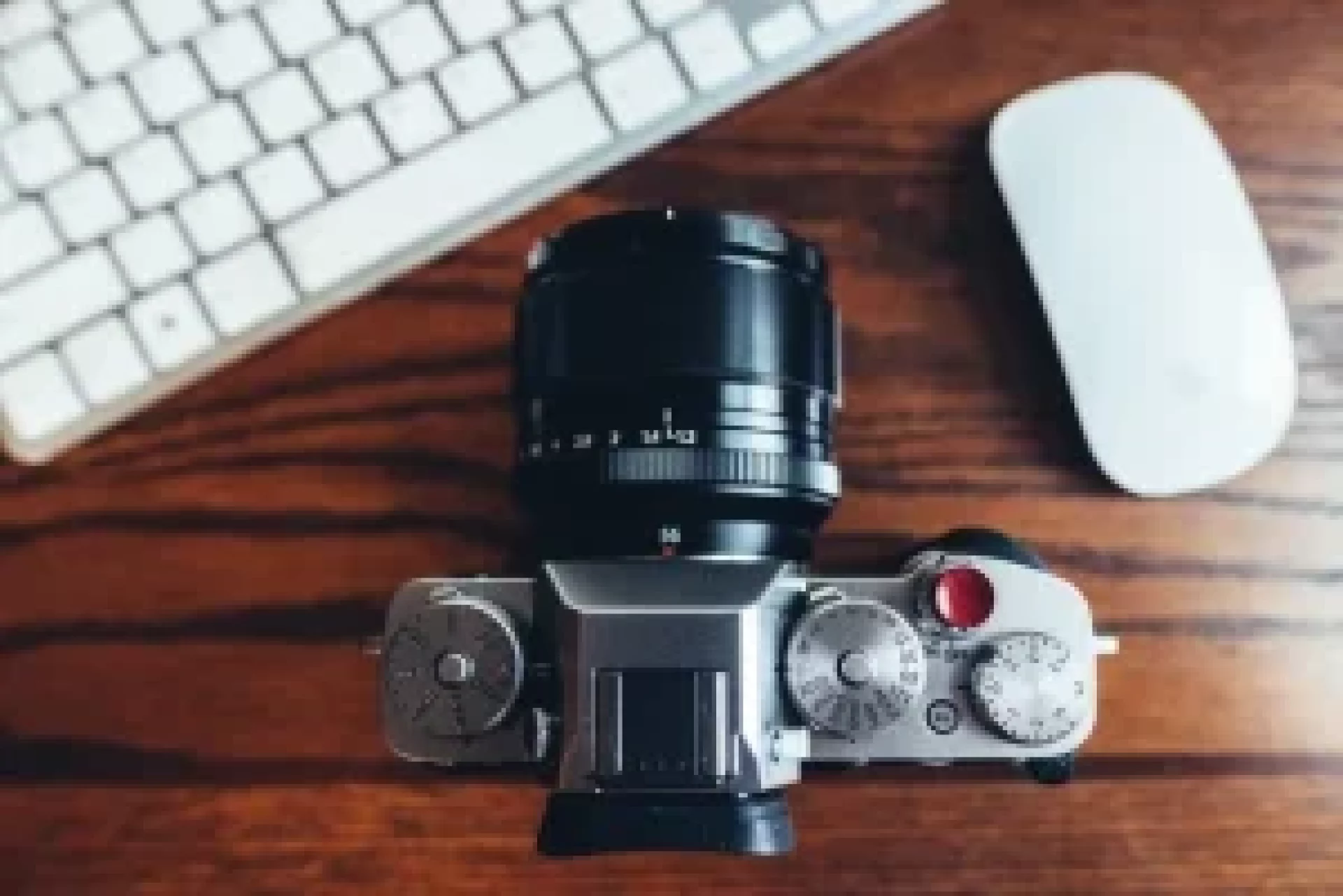
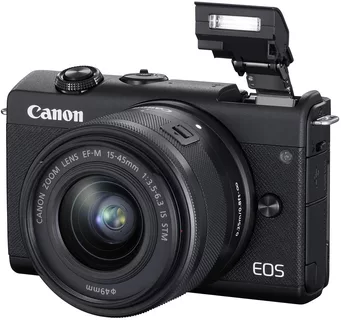














sildenafil price costco
February 23, 2023 @ 3:24 pm
sildenafil at walmart pharmacy
sildenafil uk 100mg
retin a cream price india
February 13, 2023 @ 4:50 pm
tretinoin cream 0.1 buy
tretinoin cream prescription cost
The FUJIFILM X-T30 Review Good points and bad points » Camera Gear
January 9, 2022 @ 1:14 pm
[…] Fujifilm X-A7 mirrorless camera review […]